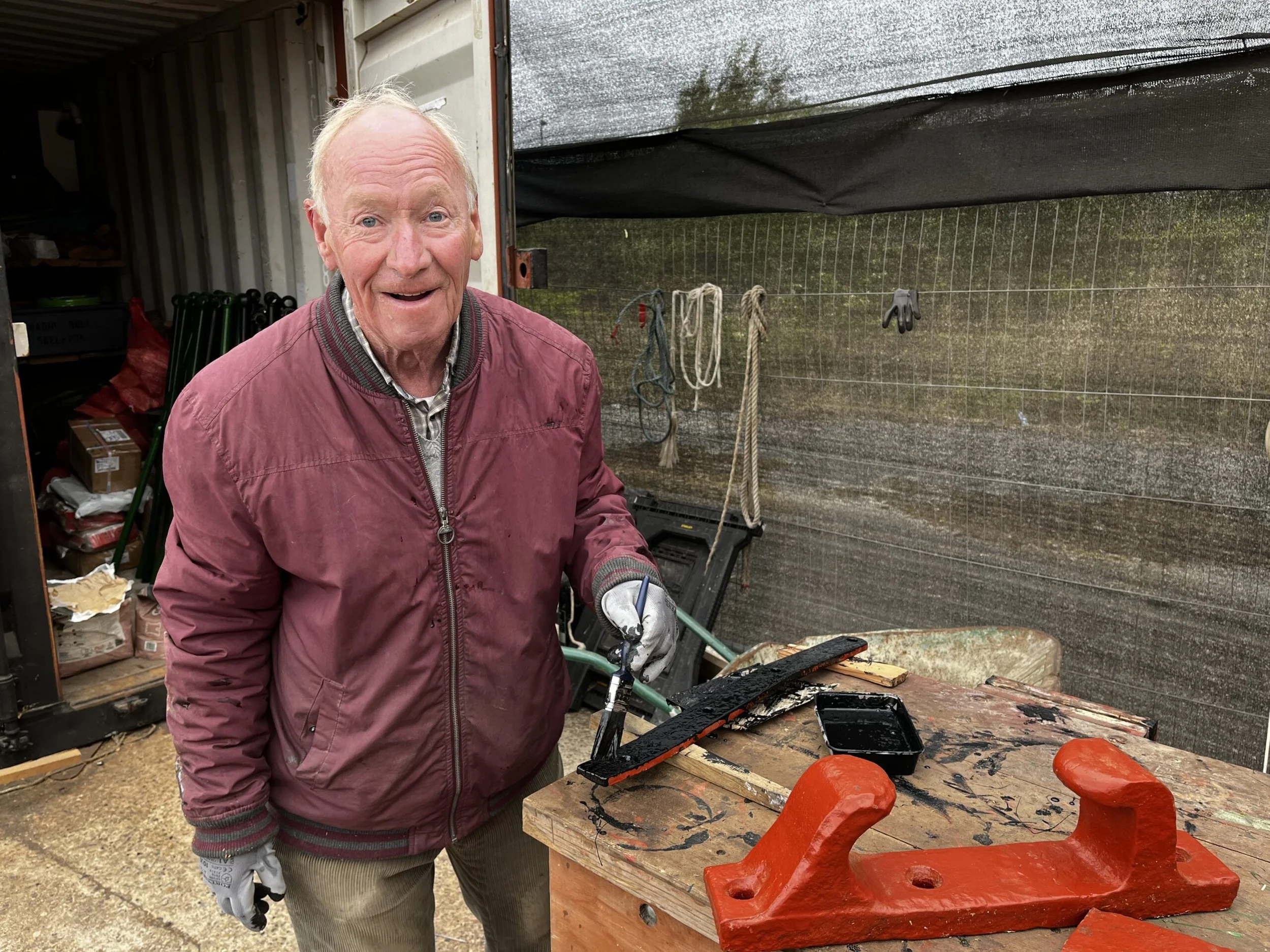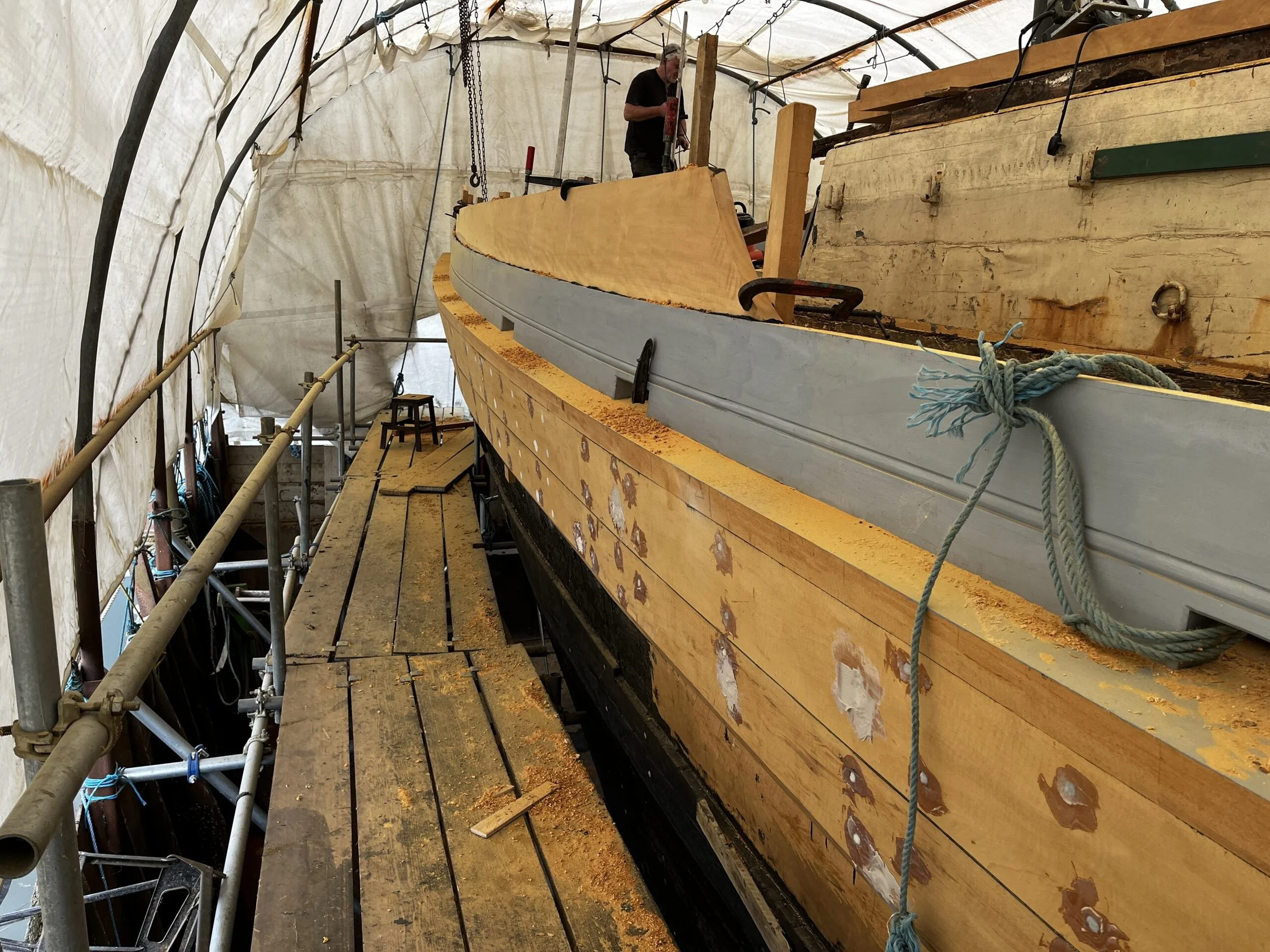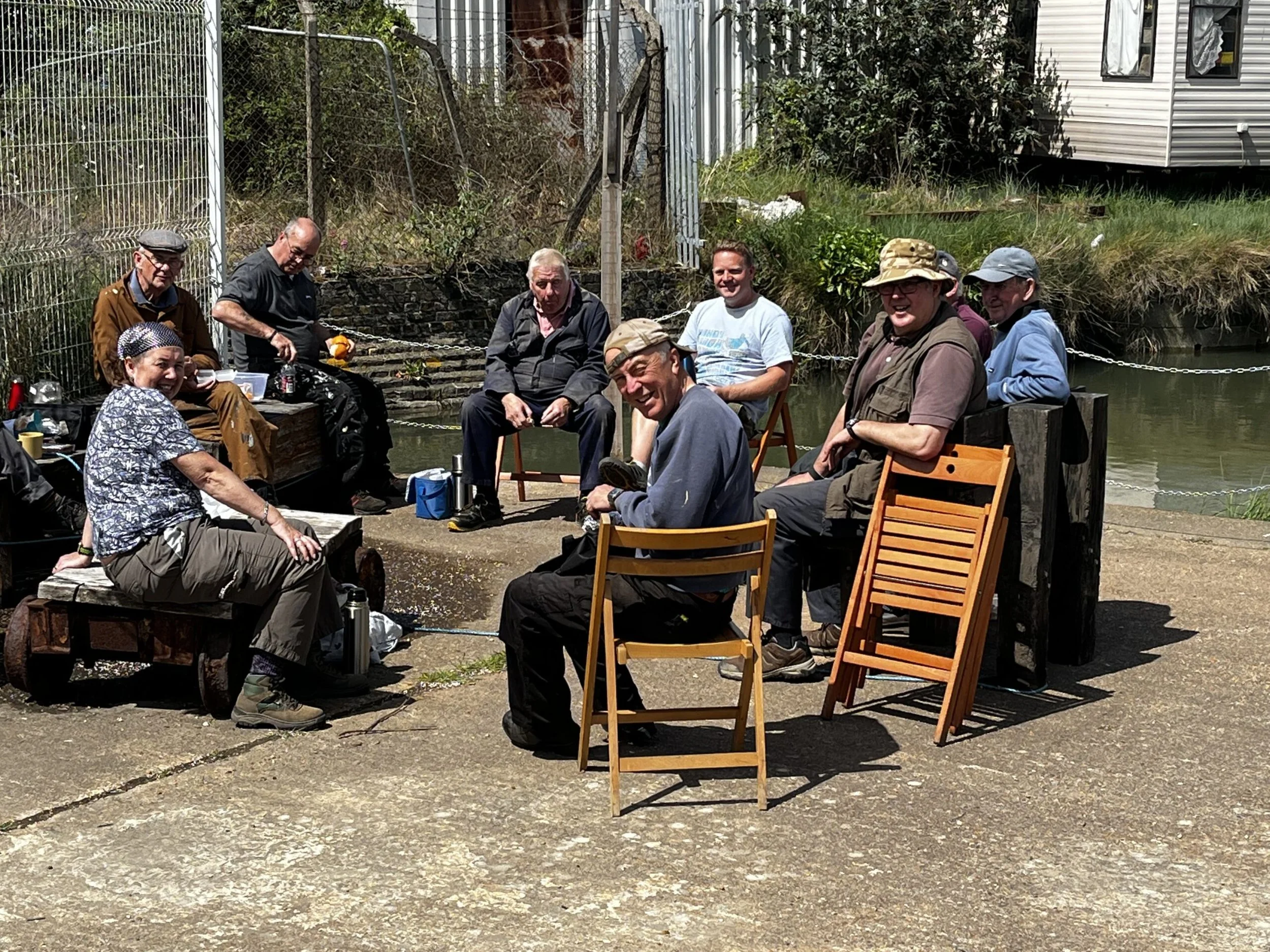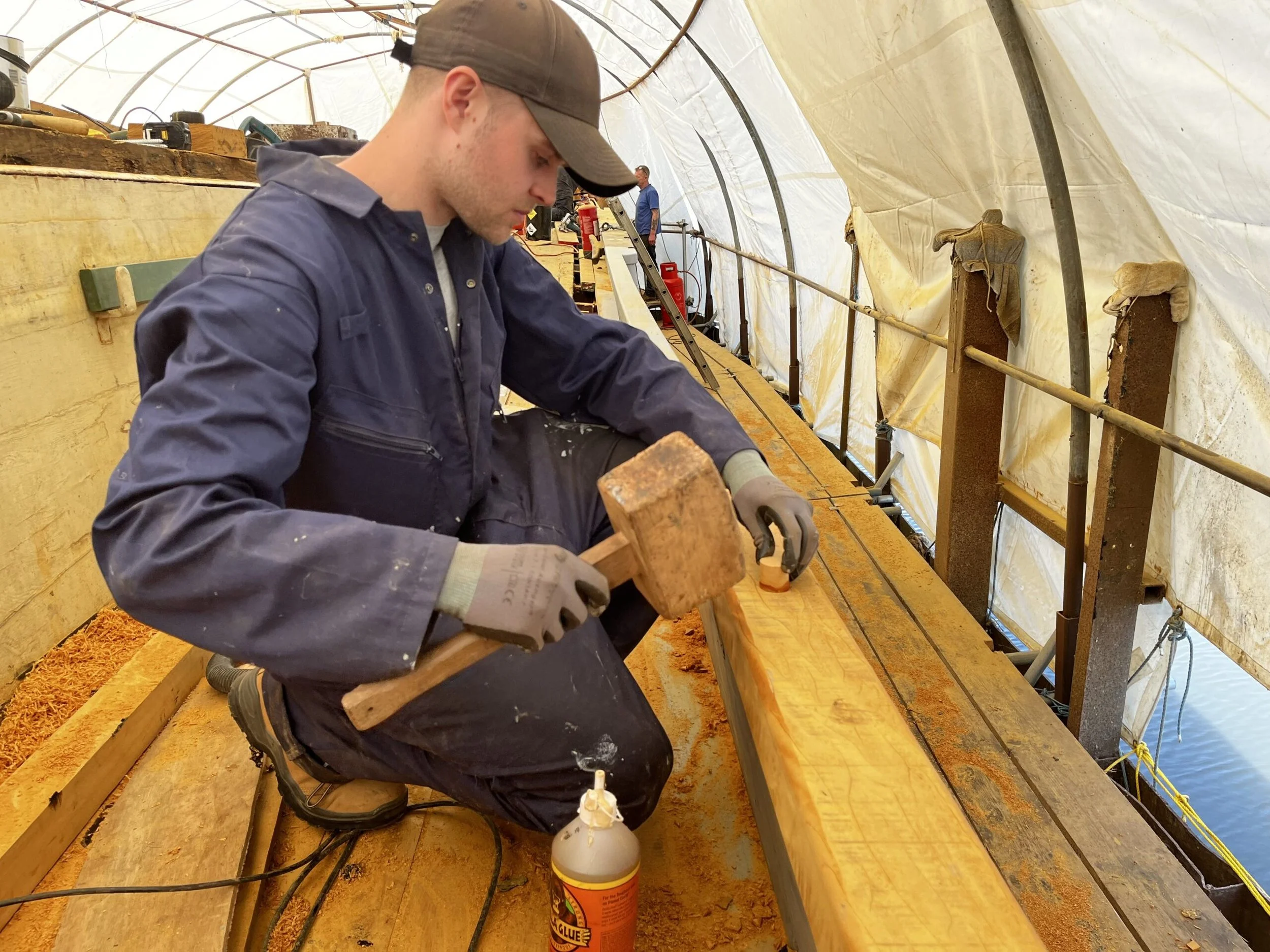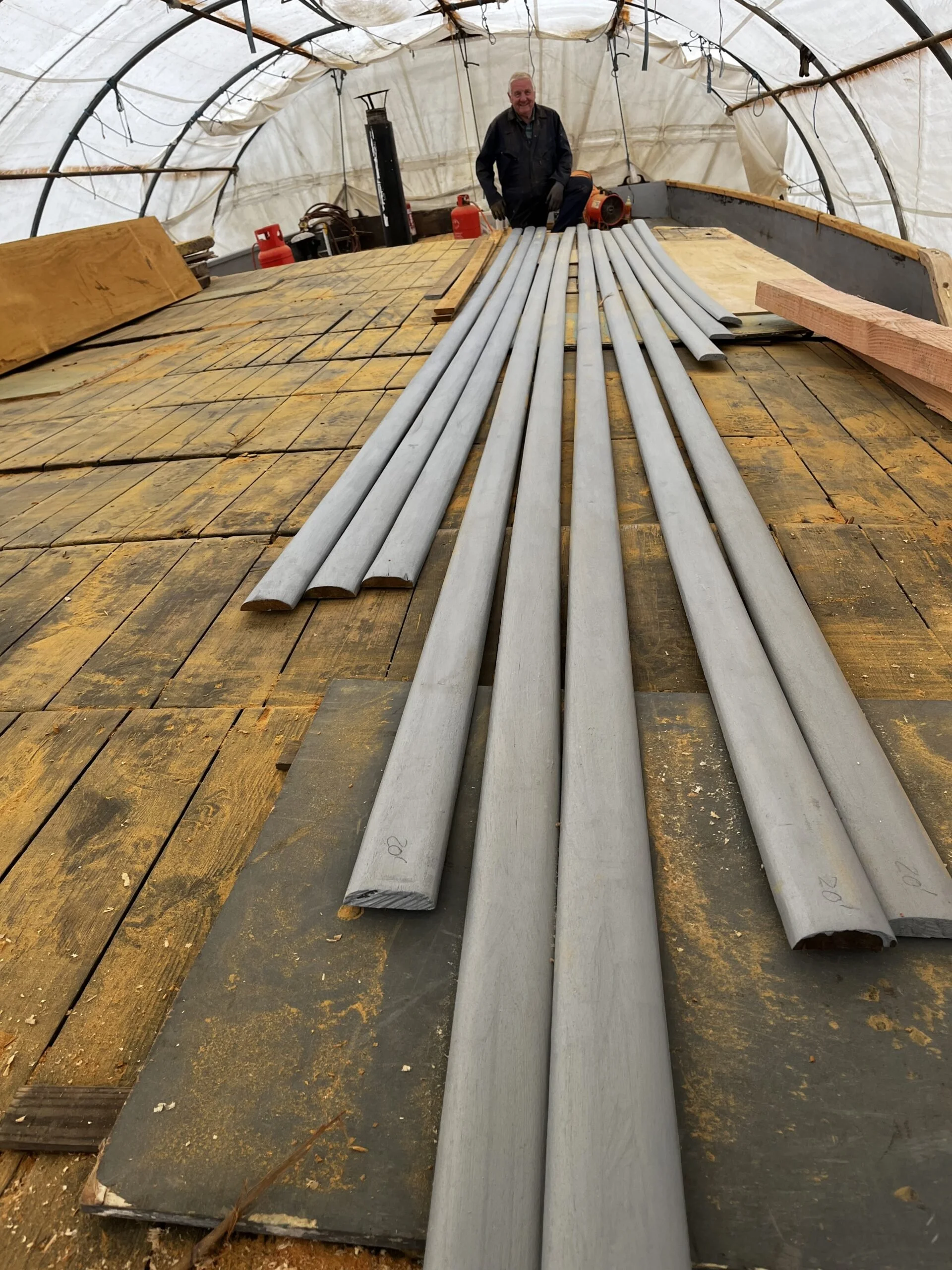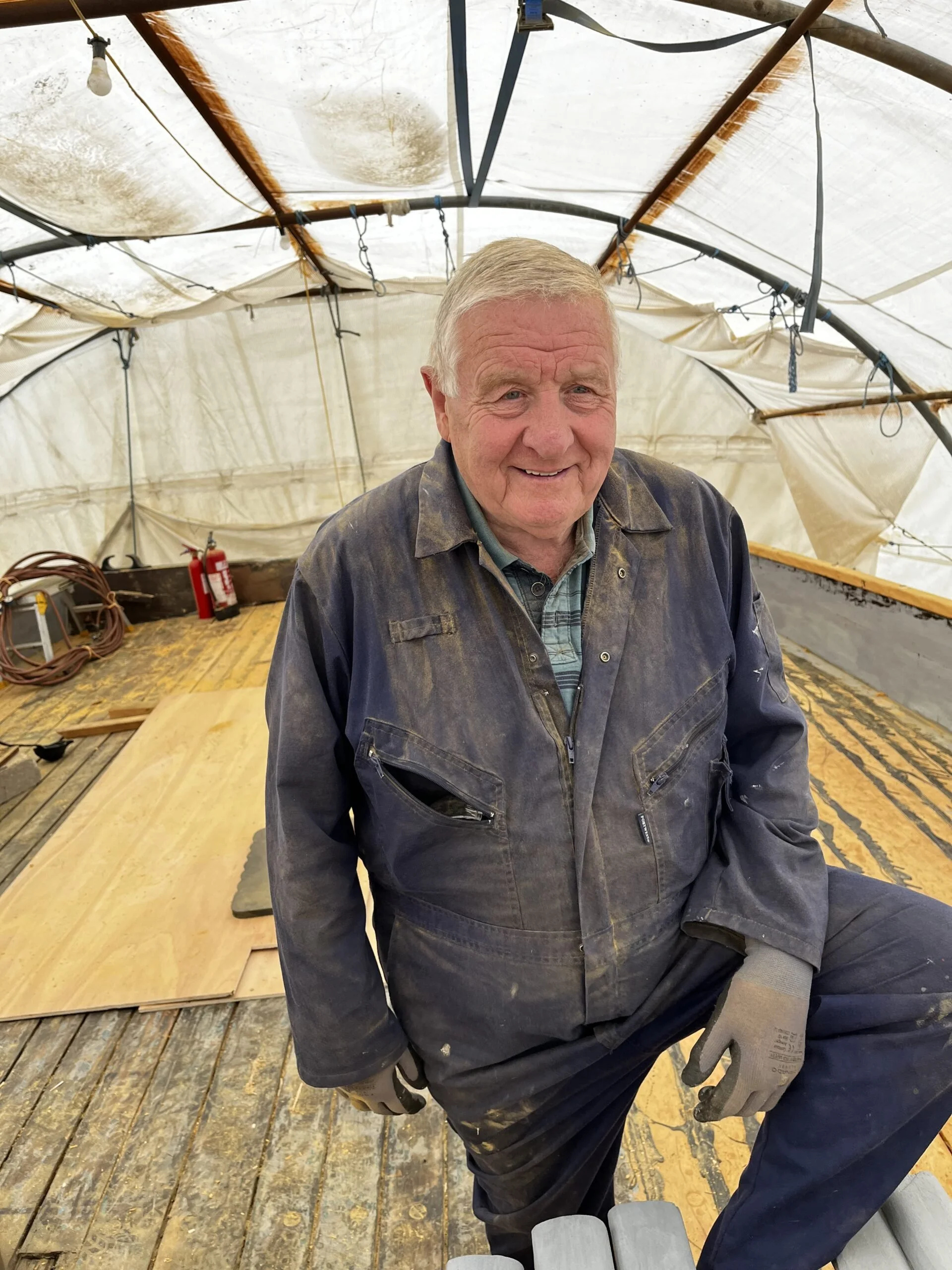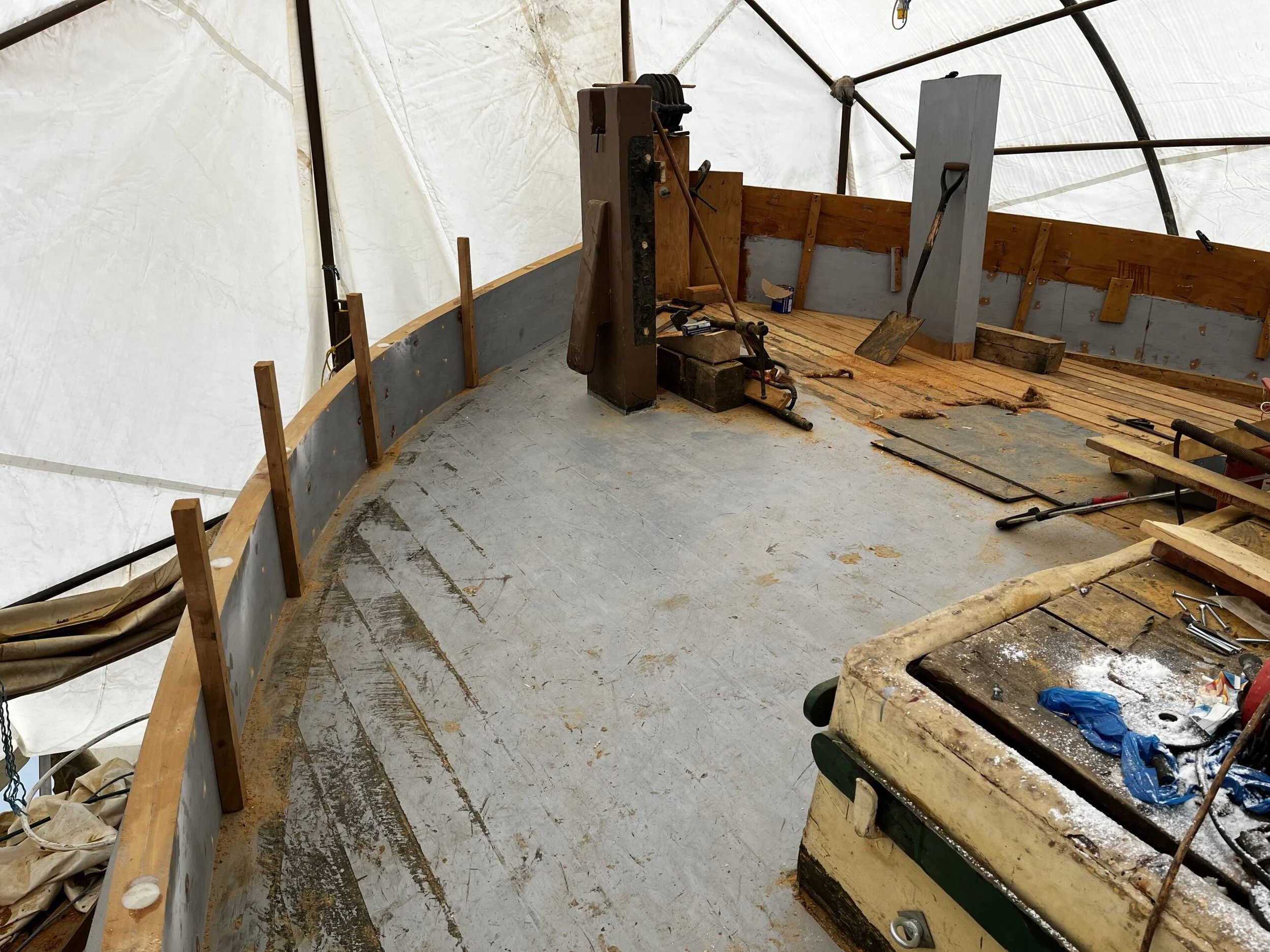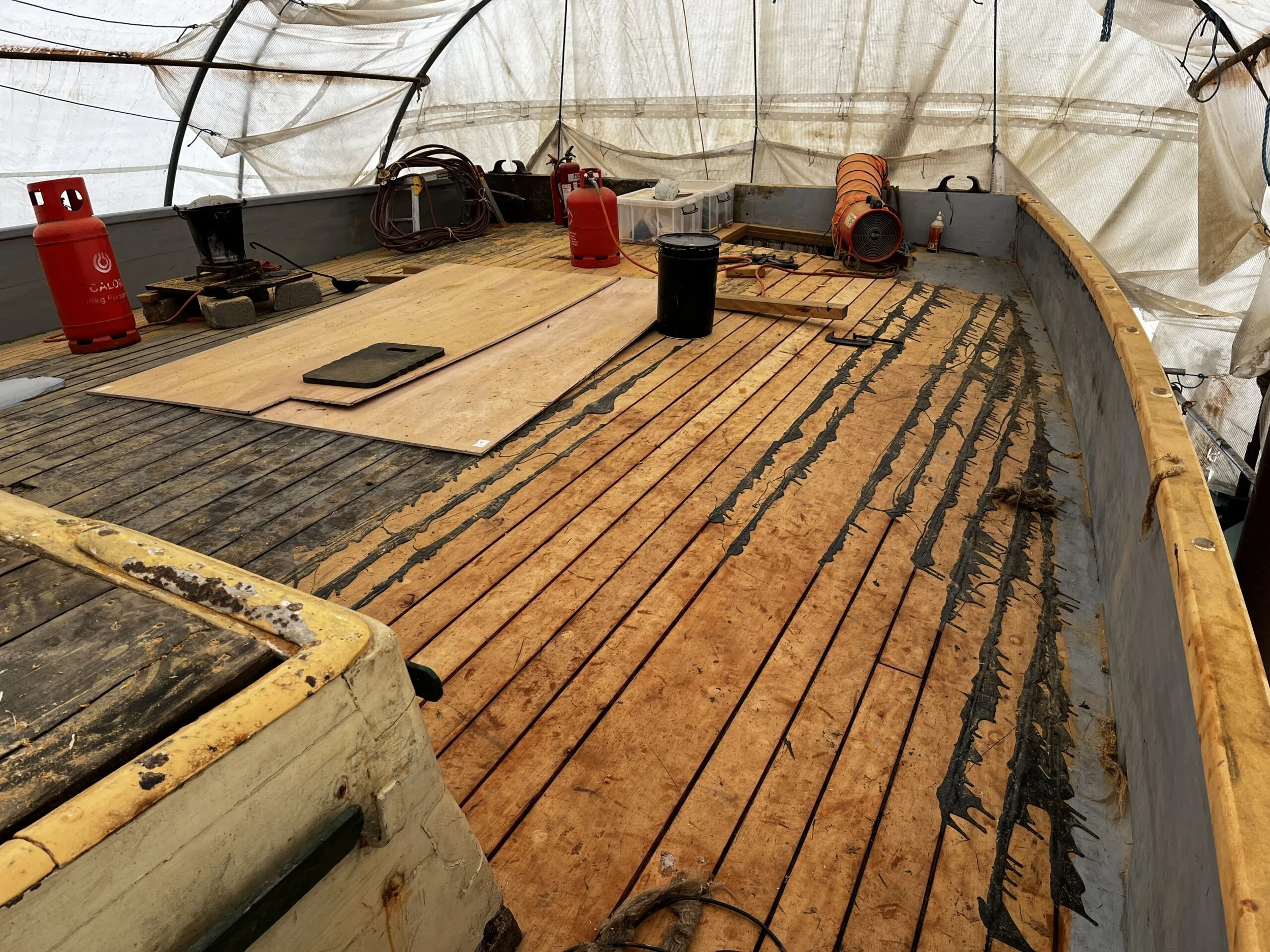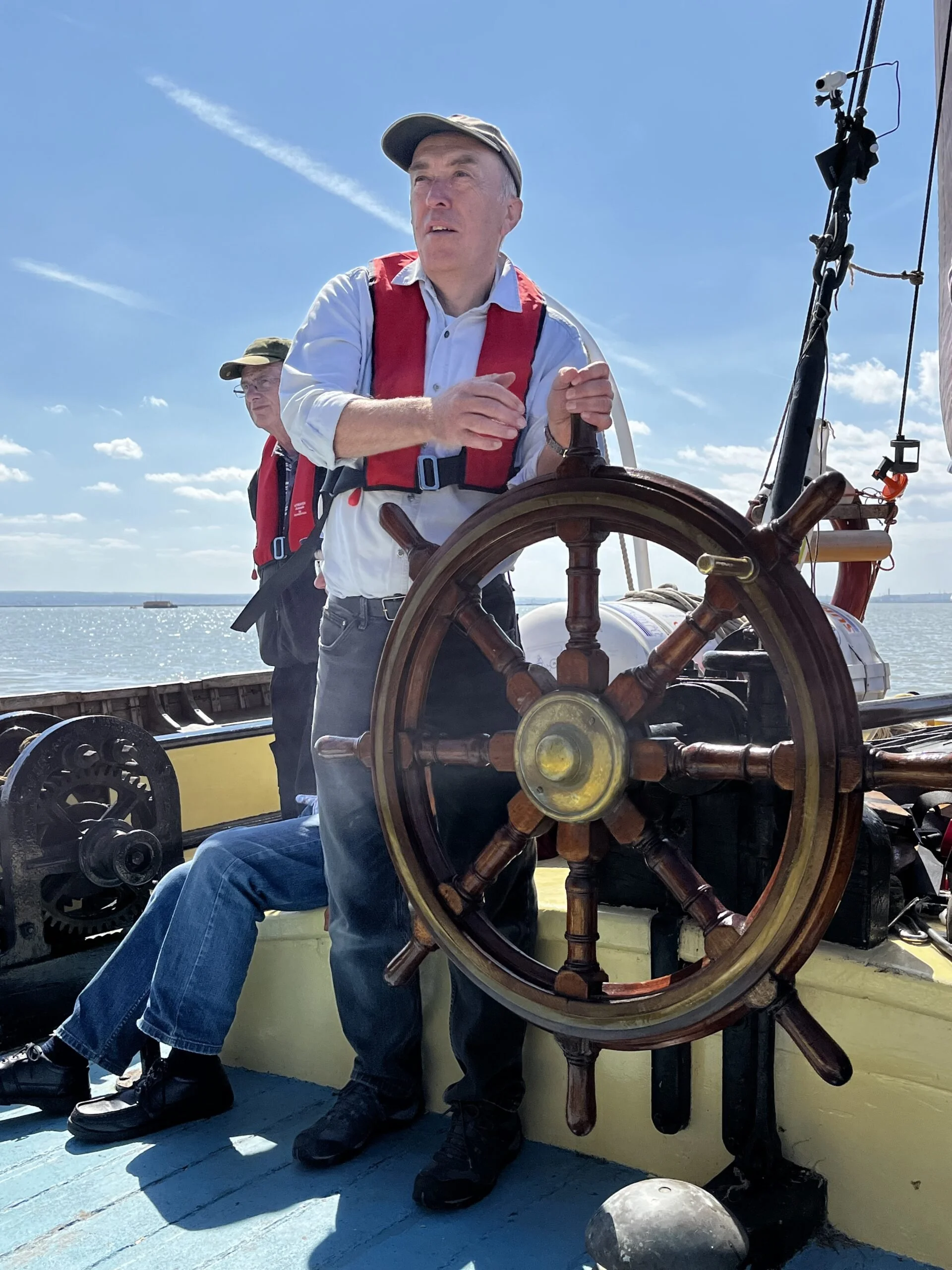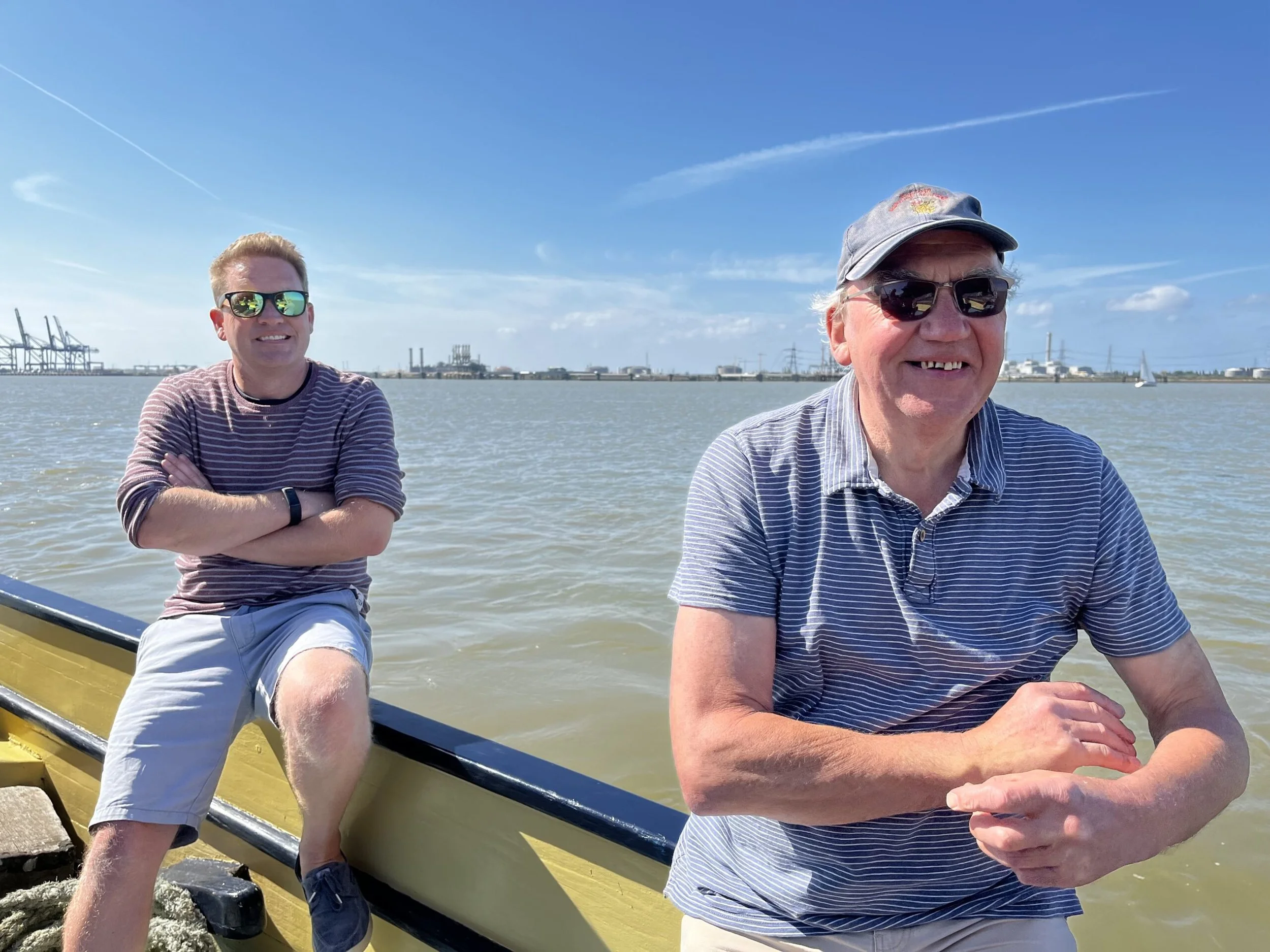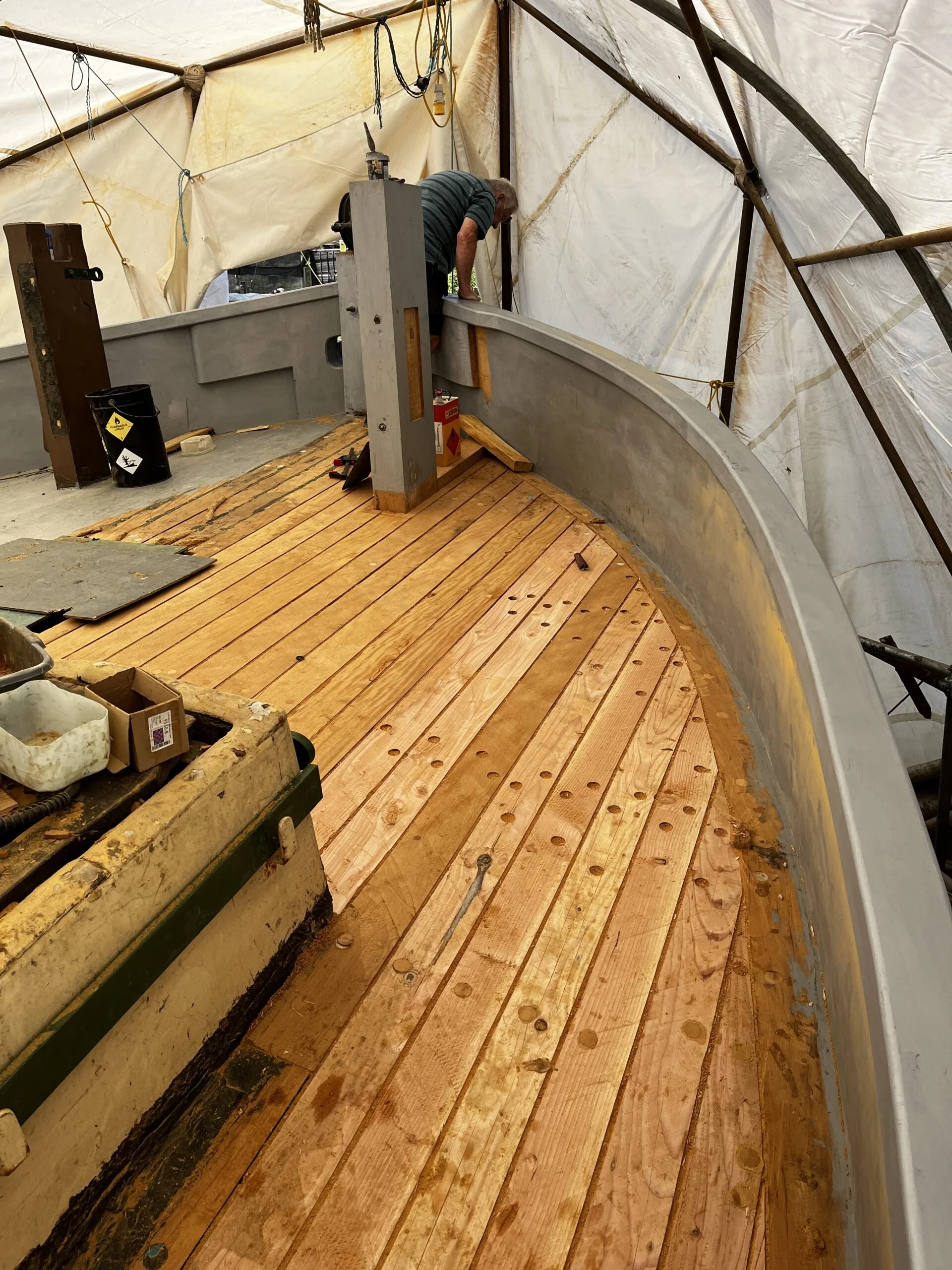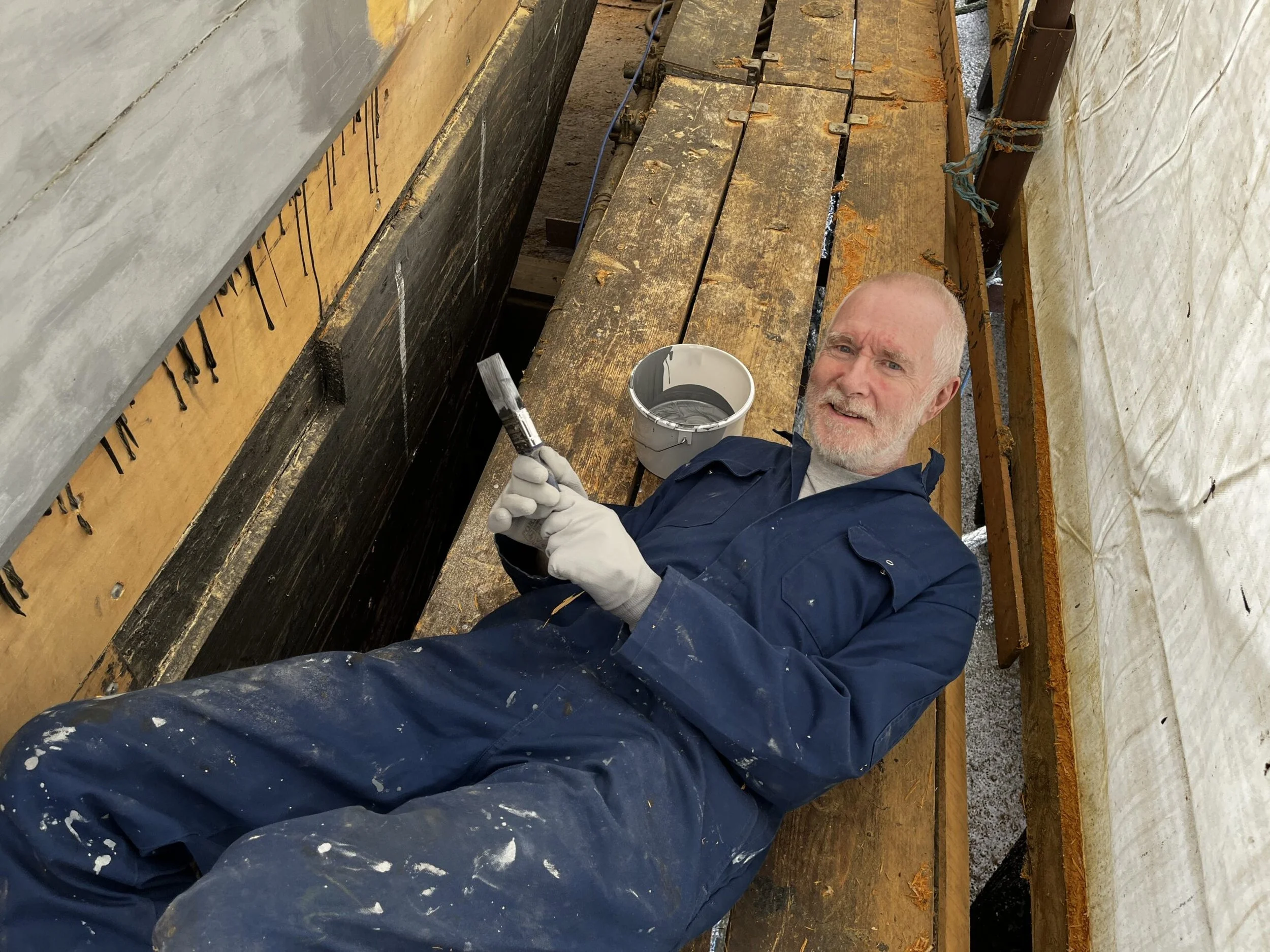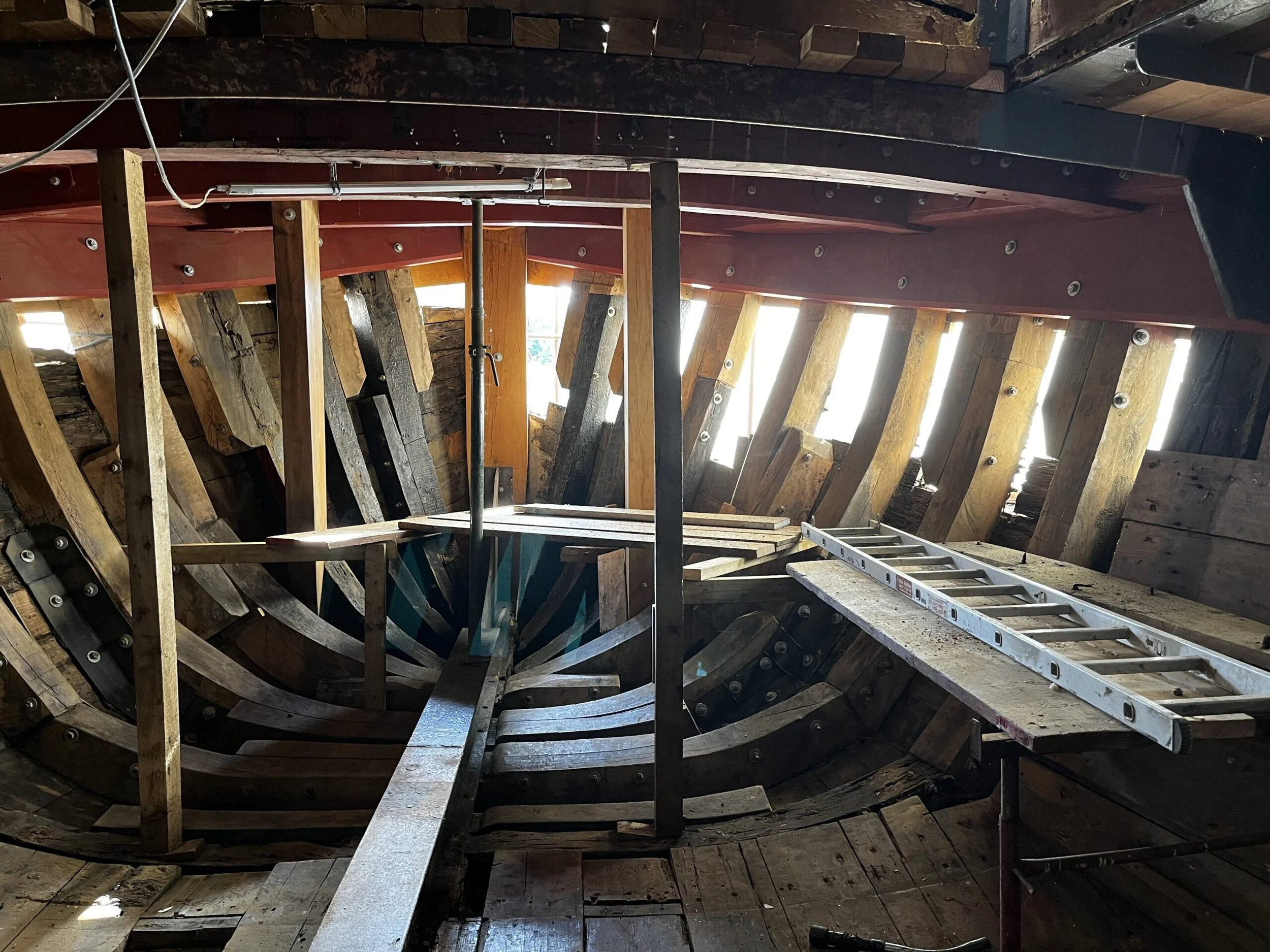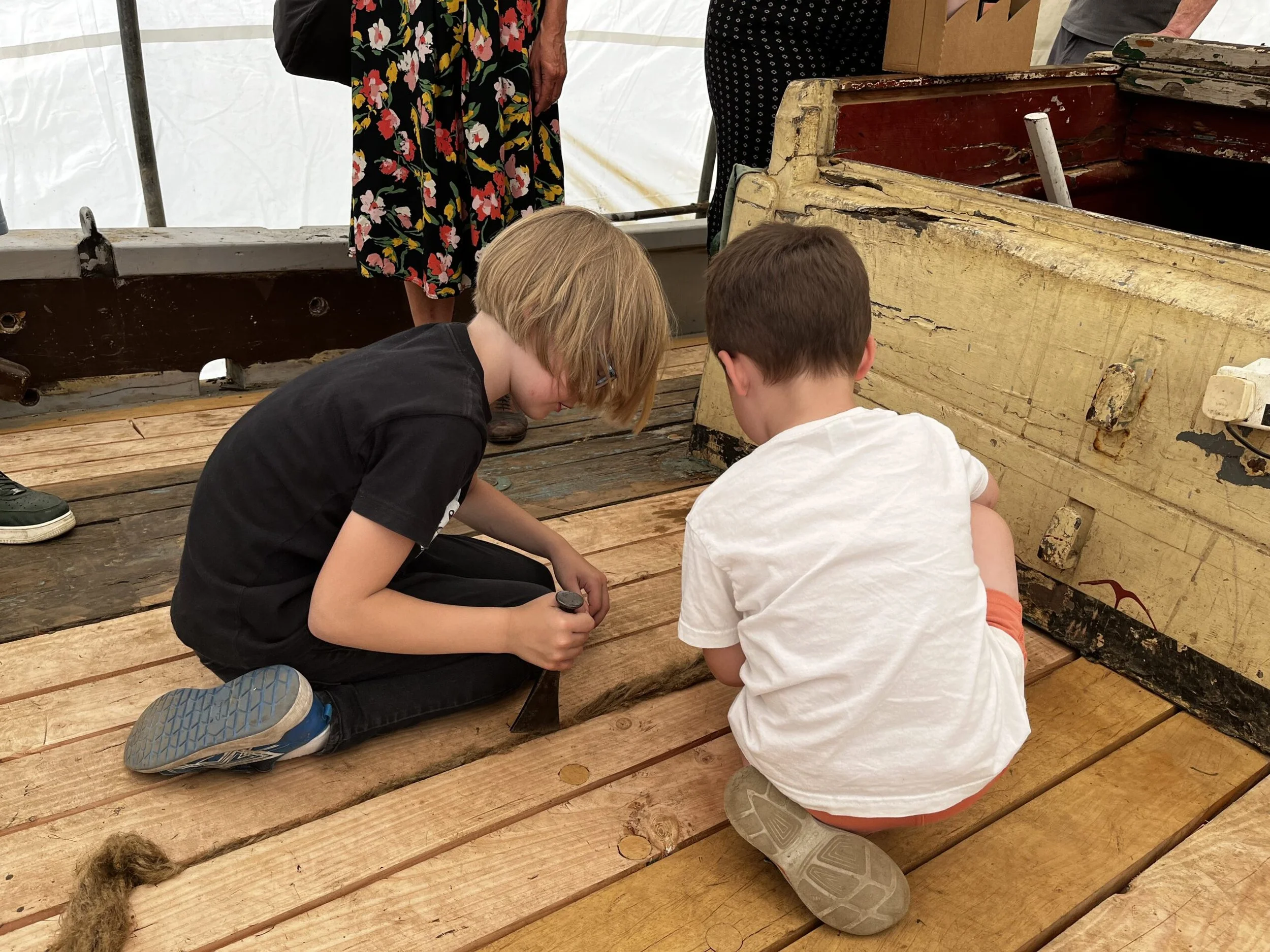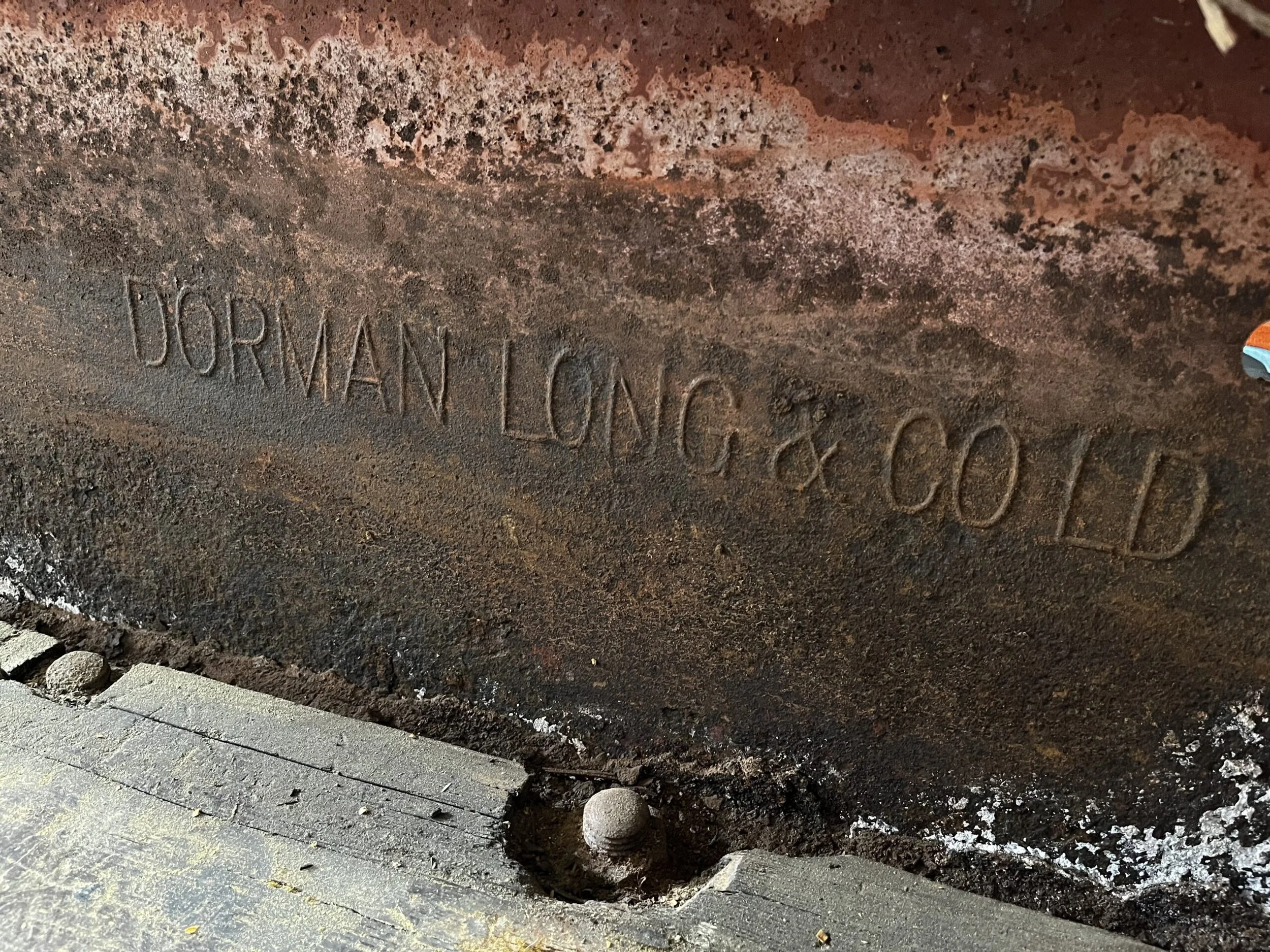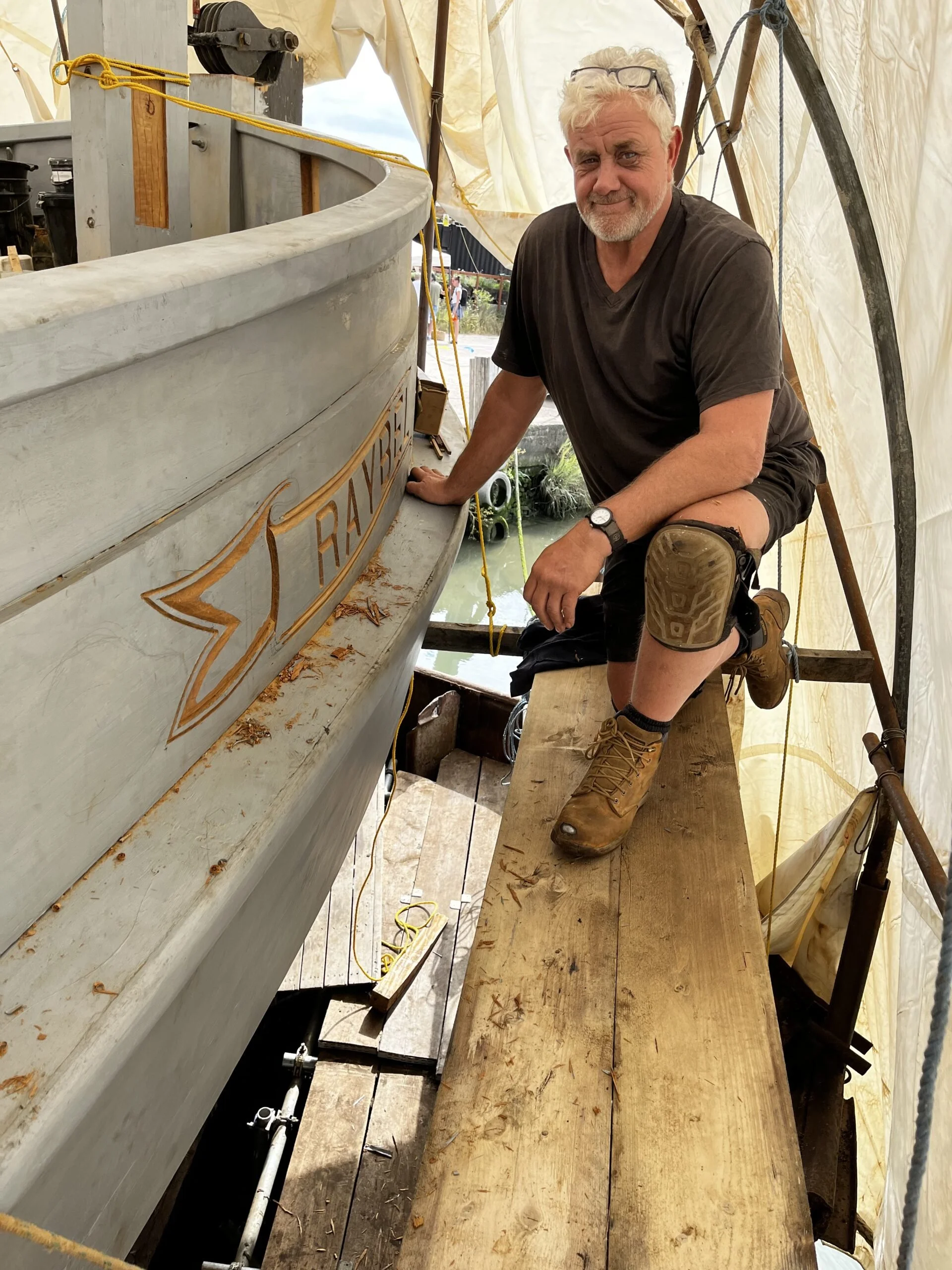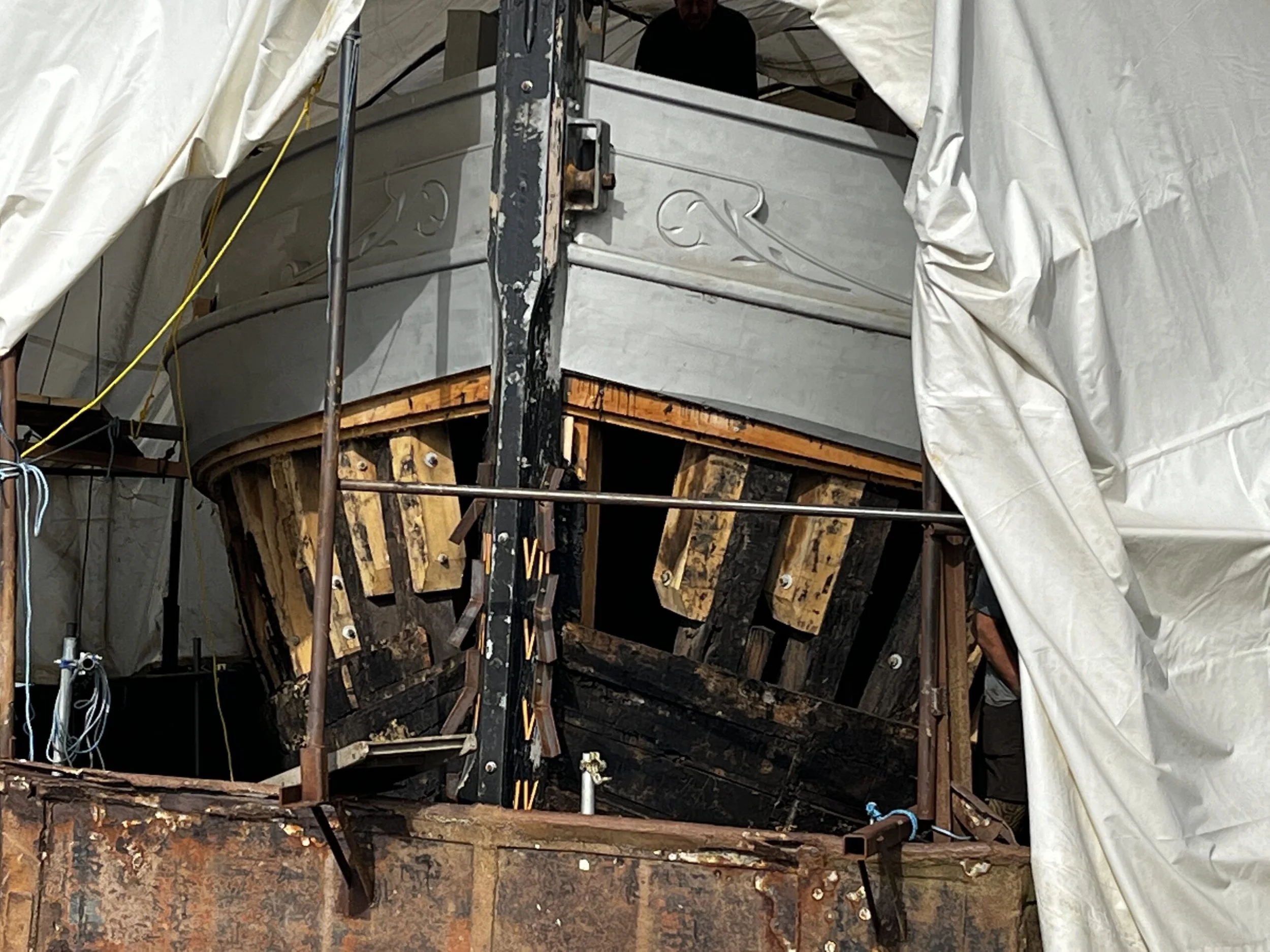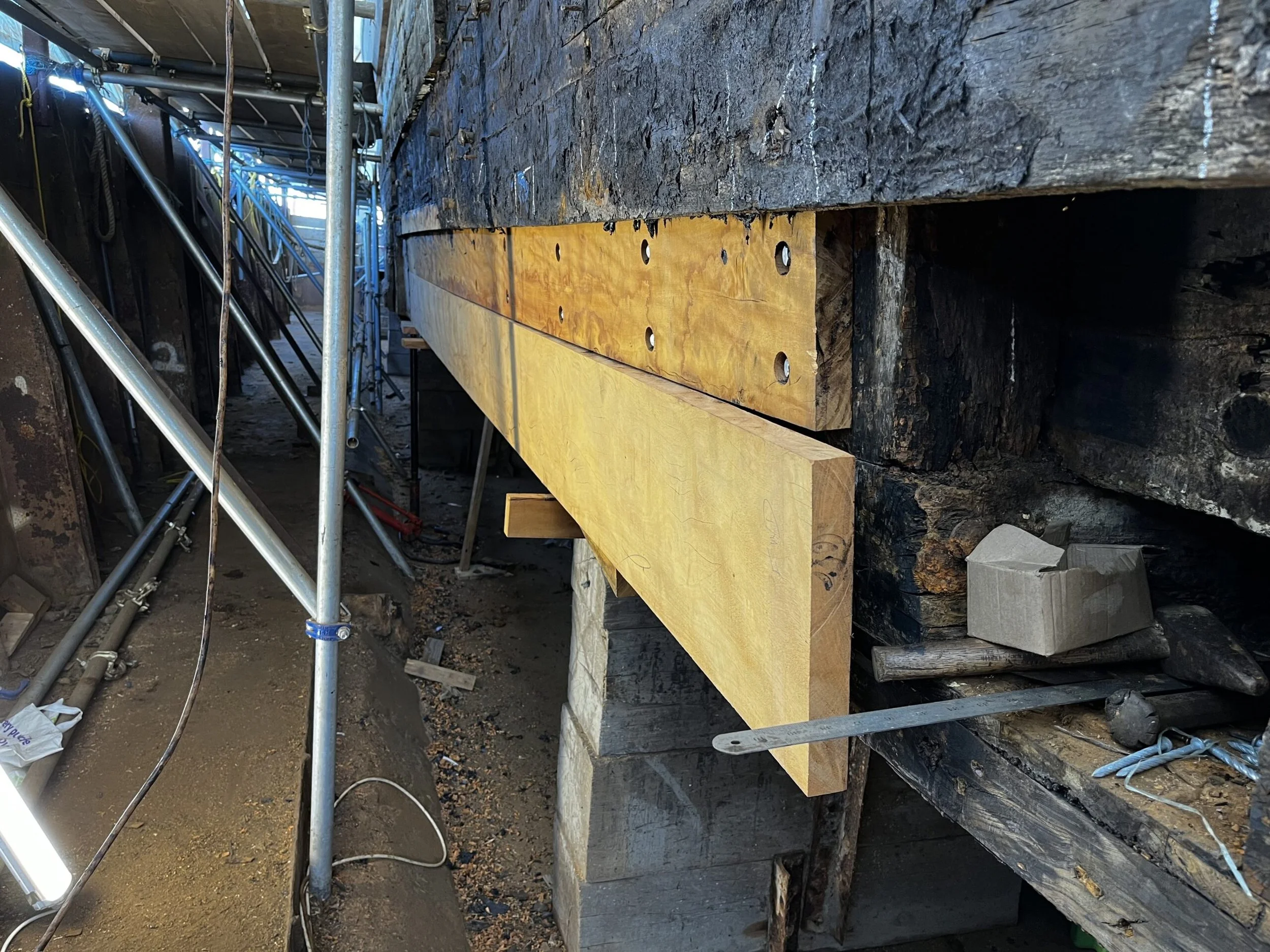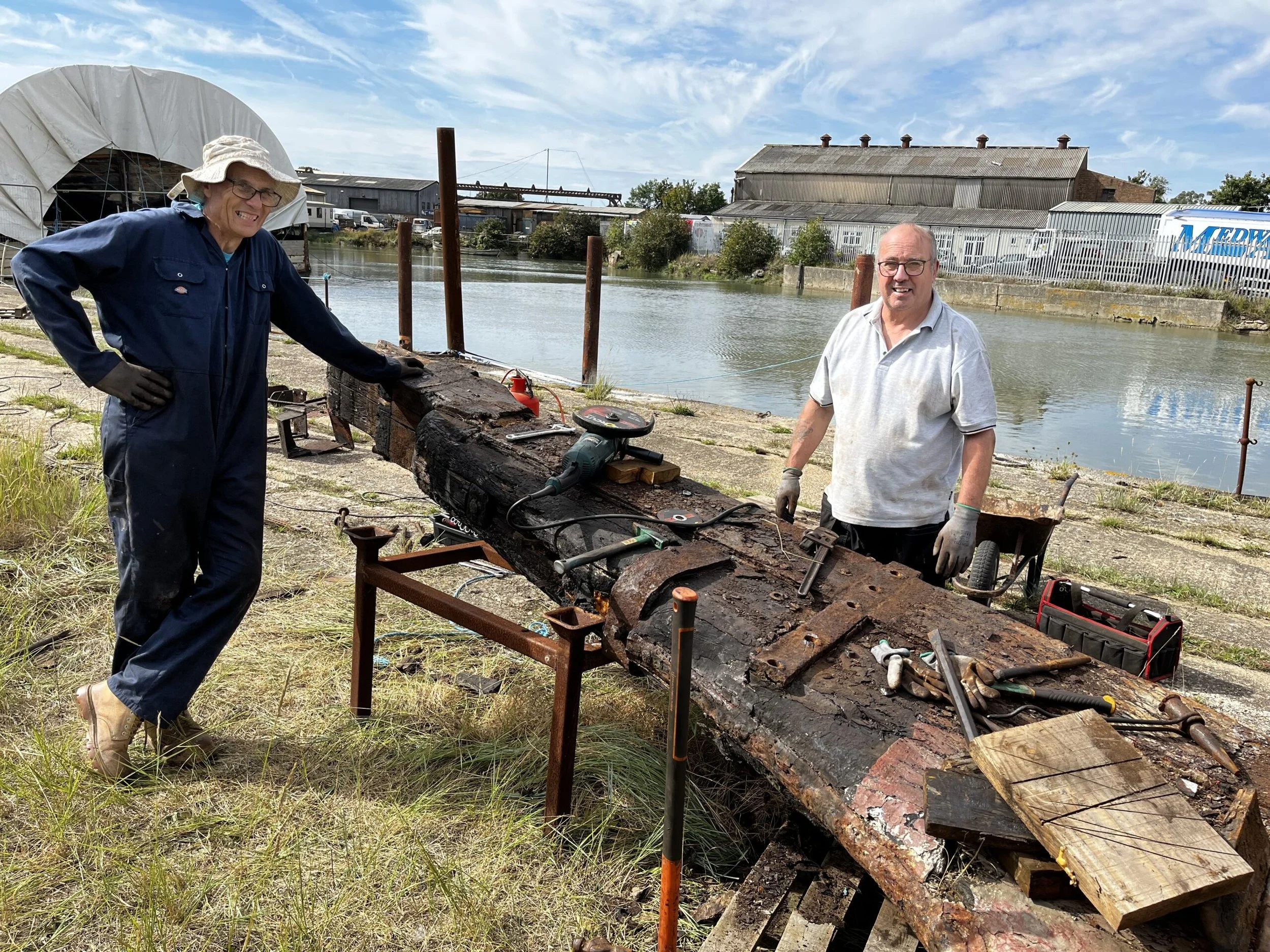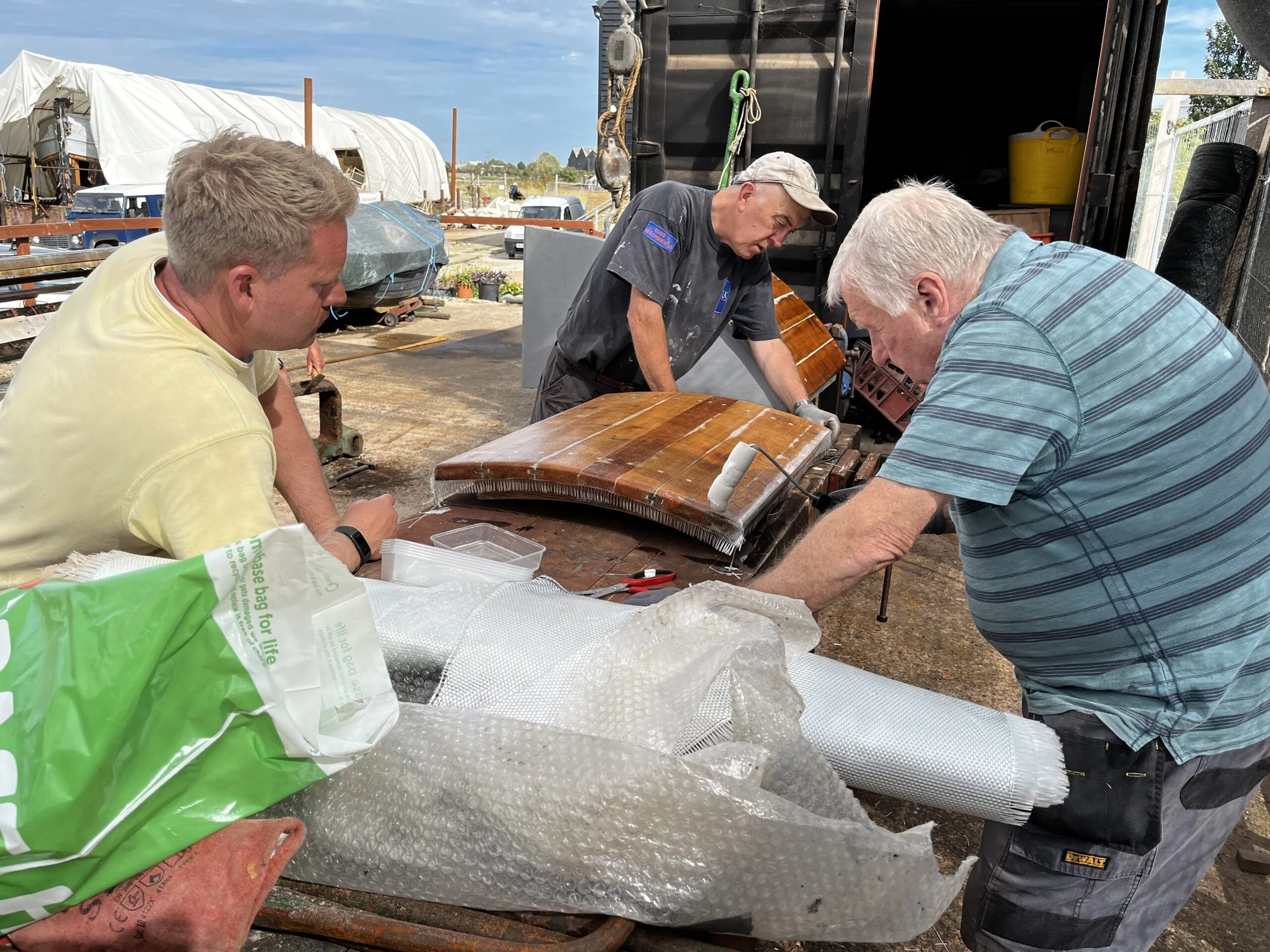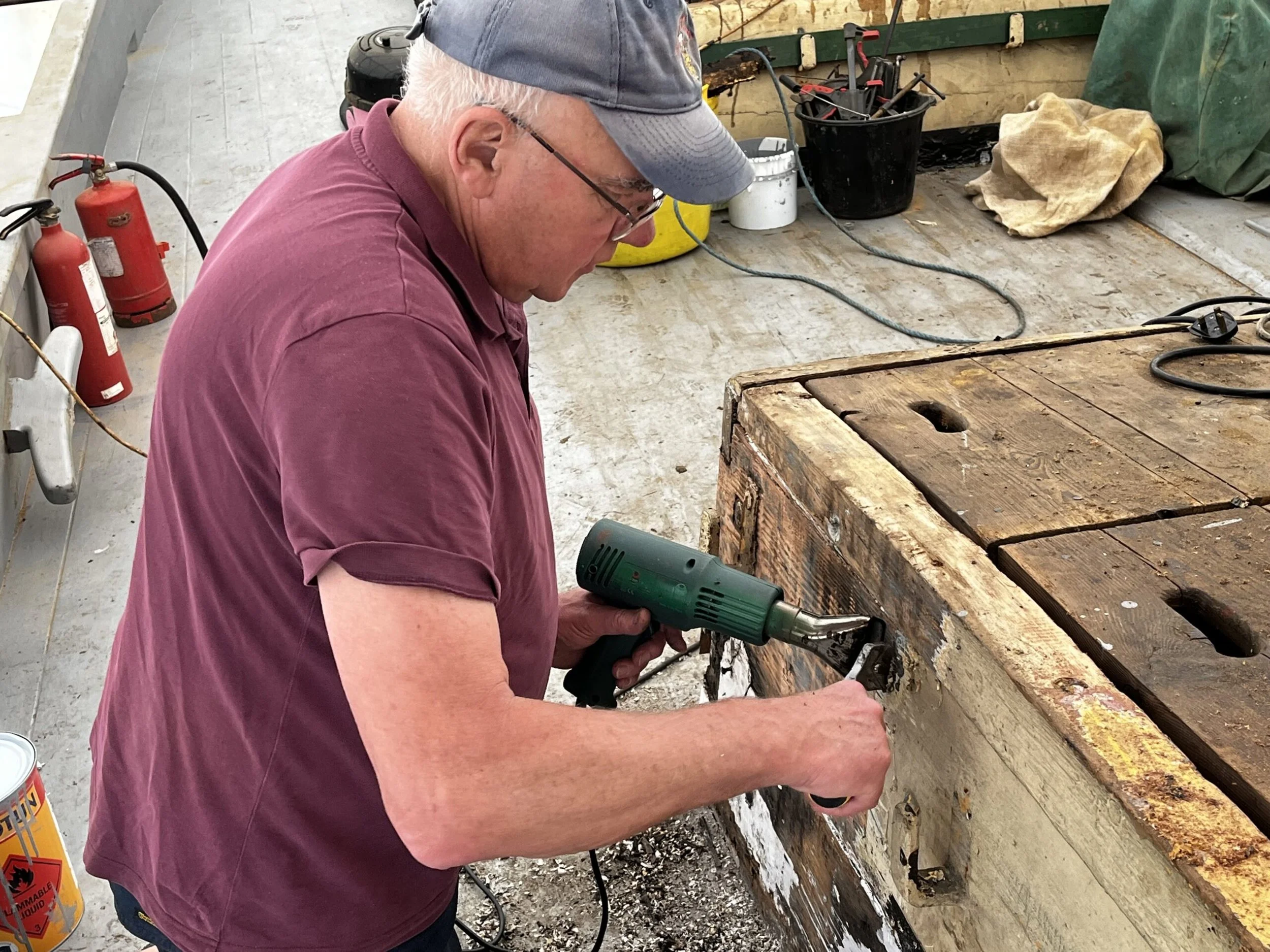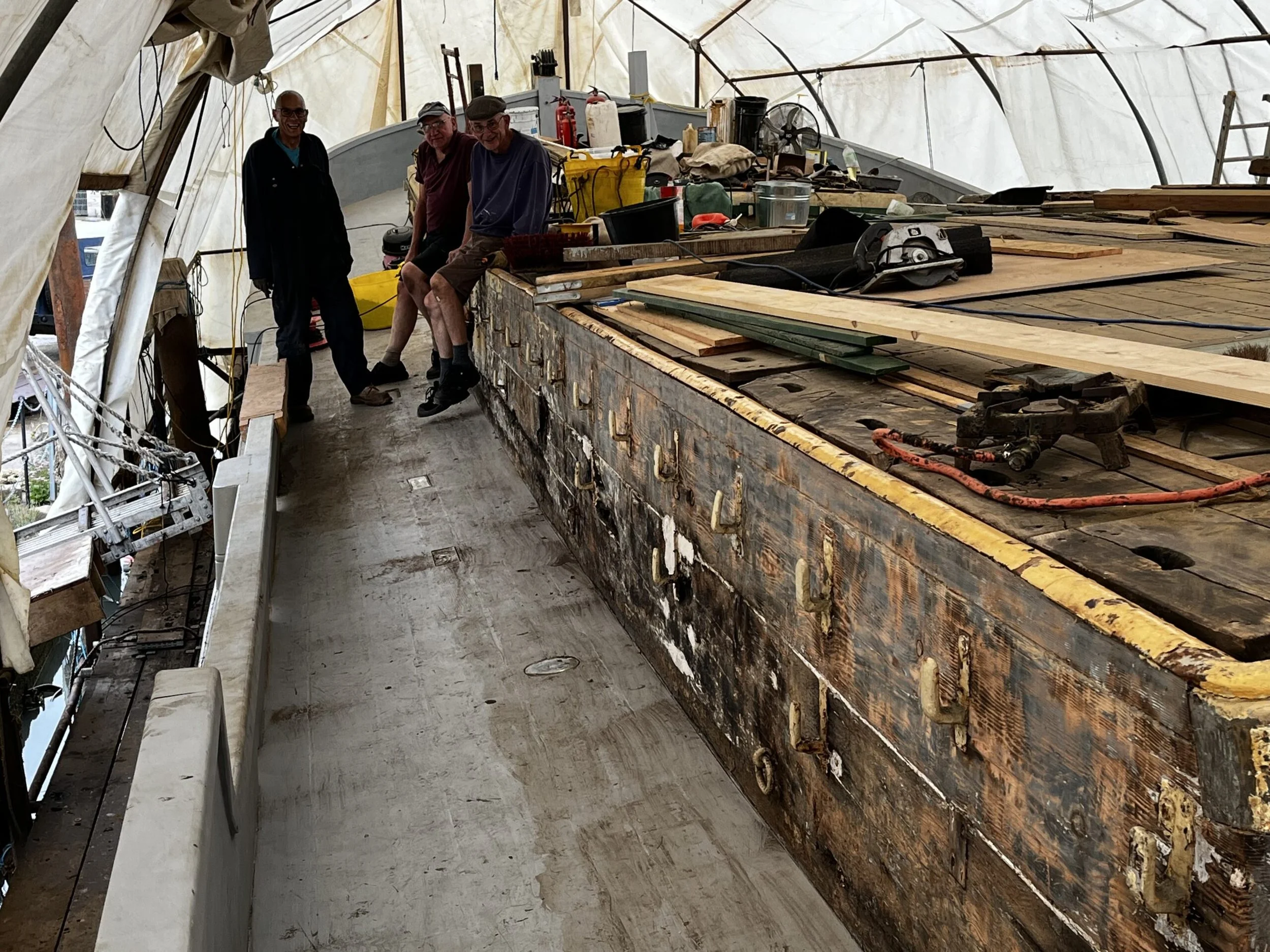Filling the gaps
June - October 2022
During the summer of 22, the shipwright team of Tim, John, and Josh, completed the covering boards which join outer wale, frame tops and inner wales with the carlings and deck beams. Rails were steamed to bend round the deck shape- 2 thicknesses of inch and a half Opepe wood all bolted together with 12mm galvanised panhead bolts, washers and nuts. Holes filled with wooden plugs and epoxy resin sanded smooth. On top of the rails squarish section cappings with nice rounded edges finished the job.
The steaming was done by sliding the plank into a polythene tube, then sealed at both ends. An old gas canister on a big gas burner serves as a steam generator and after 2 or 3 hours of steaming, the plank is clamped into place still in its plastic shroud. This is tricky work as it’s too hot to hold, dripping scalding water, and is slippery in the tube. Another hour and the plastic is removed to do a fine fit of the plank ends. Overnight it cools and dries so that it can be bedded on mastic and bolted home.
It’s been a wonderful hot summer for sun lovers but the high temperatures have taken their toll on wooden boats. There are some scary gaps around Raybel’s after quarters but the shipwrights assure us they will close up as soon as Raybel hits the water once more.
Rigging chocks and knightsheads
The huge rigging chocks on either side abreast the main mast were secured with dumps – 3 foot long 20 mm mild steel rods, pilot drilled and then driven in with a big hammer. These chocks have to take the sideways strain of all the loads on the mast and sails. The dumps are driven in as a tight fit but it is actually the surface rusting and expansion which fixes them hard into Raybel’s hull. Later on 20mm thick steel straps known as chainplates will tie them to the hull.
The areas around the stem and apron are reinforced with chunky knightsheads. These take the strain of the anchor and transfer forces from the stem post and windlass down into the hull of the boat.
The decking work was completed with Opepe and some Douglas fir. The epic process of caulking the decks was completed in September after three months of hard physical work by our volunteers and a couple of days by the shipwright to boost the programme. Hot pitch is poured onto all the seams in the process called paying. When solidified the surplus was scraped off with a hot scraper (very dirty job) and then the whole lot painted with several coats of our zinc rich primer.
Four cast-iron fairleads and four cast iron bollards were chipped, wire brushed, and treated to an etch primer and rust resistant topcoat enamel in black. These have been bolted onto the deck intercepting frames and knees where possible. 12 additional cleats were cut out of 3 inch Opepe on a bandsaw and finished with a disc sander.
Scuttle hatch salvo
A scuttle hatch was recovered from a skip at a local boat yard and refurbished by the volunteers. This included an epoxy resin and glass mat coating on the top to ensure waterproofness and new wash boards were made from scraps of Opepe. Josh then made a closely fitting base upstanding on the aft deck and it will all be bedded down on mastic . With the rails completed, Tim Goldsack spent our open day in July recreating the Raybel name badge that we had recovered from barging legend Barry Pearce. Barry removed the original in 1960 and it stayed in his shed in Maldon until we recovered it to use as a pattern for the new one. Tim decided to make it slightly smaller than the original as he felt it fitted better on the rails. The whole job was created with hammer and chisel by Tim suspended on some planks hanging from Raybel’s steel cover hoops. Some more elegant scrollwork badge-boards was added forward and aft. Later they will be picked out in yellow, gold, duck egg blue and red highlights as the original.
At this point with her topsides all intact and painted in primer grey, Raybel looked rather handsome. Not for long. A critical new phase was about to begin…
Back to the bow
We know that Raybel has had two collisions during her life (1938 and 1953) and there was certainly a problem with the port side bow area which has been covered with a huge plywood patch for many years. Working from the stem backwards, the shipwrights removed all the damaged and rotten timber from Raybel’s hull. The timbers were stripped back to the frames. With the cover pulled back to provide ventilation during the hot summer, Raybel looked like an emerging shark bearing its teeth.
At the bottom corners, the shipwrights cut away the elm chine planks until they came to better wood somewhere under where the leeboards would fit. As the chines turn up to the front of the boat, there is a very important bevel joint where the side planking meets the bottom. It’s very important to maintain the integrity of that joint because it is a major risk of leaks if it is damaged.
The shipwrights then started spiling new timbers and re-cladding the hull using inch and a half Opepe wood – fixed with 150mm galvanised coach bolts bedded onto sheathing felt and bitumen mastic. The Shipwrights are working independently on a side each, only working together when cooperation is needed. Hoisting the heavy planks into place requires block and tackle, acro props, clamps, special brackets and ingenuity, combined with huge grunt.
The process will continue until the hull is sealed in late December.
During the Open day in July, most of the bow was open letting a lot more light into the front of the barge. One young visitor noticed that there was writing on the keelson which is a large rolled steel joist. The wording of Dorman Long and Co shows that the keelson came from Middlesbrough, the same steelyard that made the Sydney Harbour Bridge. Raybel is in good company!
Still needed - one rudder
Meanwhile on the hard, volunteers were charged with recovering the gudgeon irons from Raybel’s rudder. The rudder has been reinforced with steel additions over the years and with them removed it snapped in half while we were trying to flip it over with a forklift. “That’s why it needs replacing” said the shipwright Tim. “It does now!” said volunteer Kev. The fittings have all been recovered and are undergoing the repainting process. Some pieces will have to be repaired by welding and new bushes may be needed in the pivots. When remade, the whole shebang will have to be lifted by crane and lowered onto Raybel’s sternpost.
It's getting colder and darker – time to close up the cover ends and check the lights are working.

